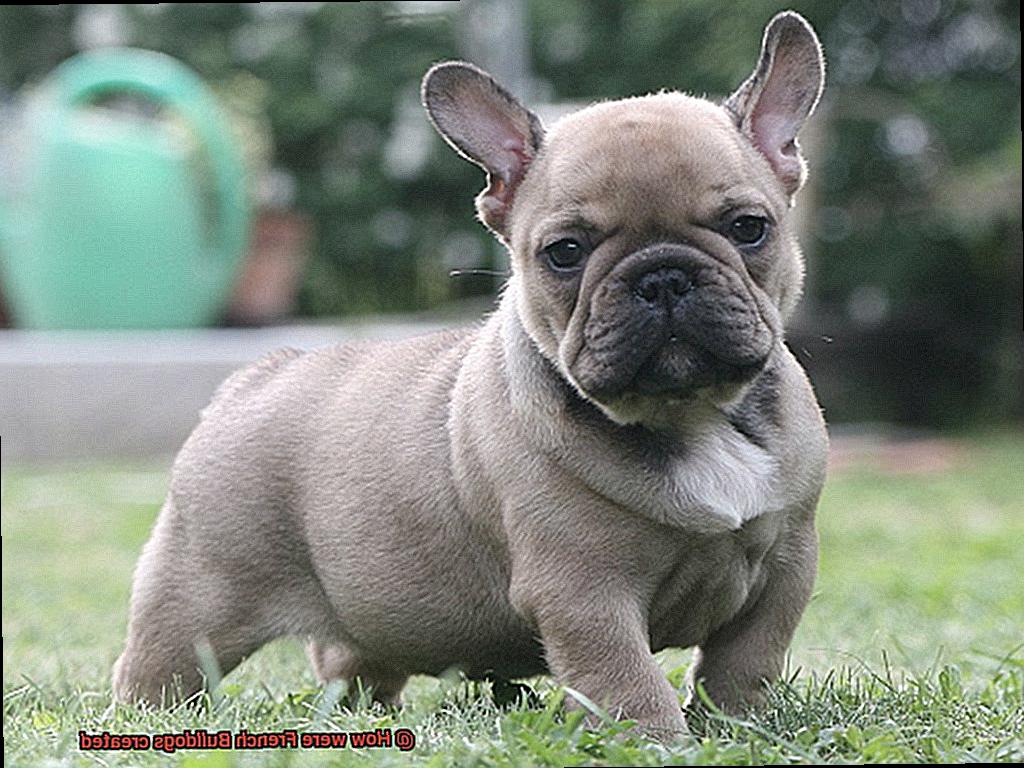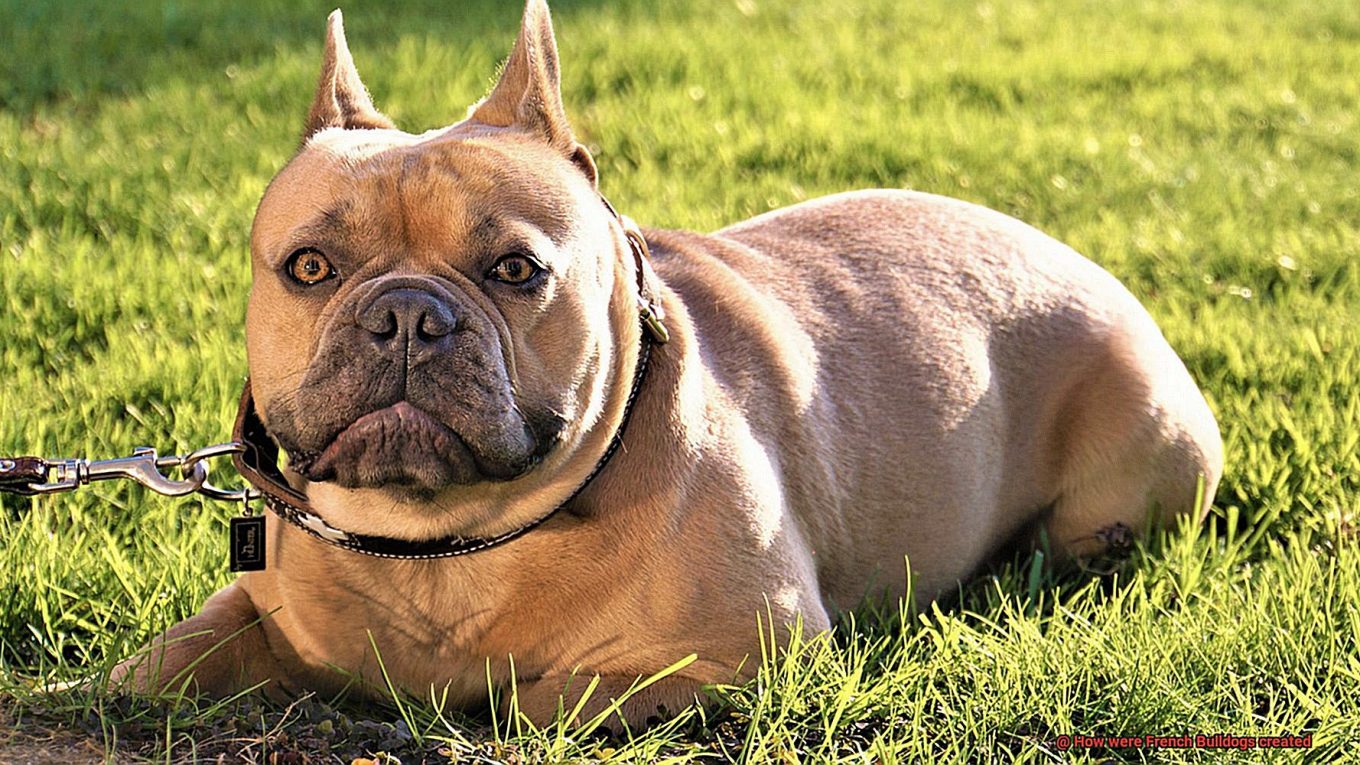How were French Bulldogs created?
Welcome to our blog post about the captivating creation of French Bulldogs.
Prepare yourself for a delightful dive into their history. Despite their name, these adorable creatures have a surprising origin story.
Originally bred as a pint-sized version of English Bulldogs, they came to life when lace workers packed up and moved from England to France during the Industrial Revolution. These furry friends swiftly stole the hearts of the French and soon won over people all around the globe, skyrocketing in popularity.
So, let’s embark on this journey together and uncover how French Bulldogs transformed into the cherished breed we can’t help but adore.
Origins of the French Bulldog: The English Bulldog Influence
Contents
- 1 Origins of the French Bulldog: The English Bulldog Influence
- 2 Crossing English Bulldogs with Local Ratting Dogs
- 3 Selective Breeding for Desirable Traits
- 4 The Role of Toy Bulldogs in Reducing Size
- 5 Standardizing the Breed’s Appearance and Temperament
- 6 Refining the Breed Through Selective Breeding
- 7 Health Issues Associated with Brachycephalic Breeds
- 8 Pros and Cons of Owning a French Bulldog
- 9 Conclusion
In this blog post, we will explore the fascinating influence of the English Bulldog on the development of the French Bulldog, shedding light on their shared history and distinct characteristics.
The English Bulldog’s Journey to France:
In the 1800s, English Bulldogs were highly prized by lace workers in Nottingham, England. When these workers migrated to France in search of better opportunities, they brought their Bulldogs along. This migration marked the beginning of the English Bulldog’s influence on the creation of the French Bulldog.
Crossbreeding for a More Compact Companion:
In France, the English Bulldogs were crossed with local terriers, particularly ratting dogs, to create a smaller and more compact version of their English counterparts. These crosses aimed to develop a breed that was better suited for city living and companionship. The introduction of local terrier genes added agility and a friendly temperament to the mix.
Distinctive Physical Traits:
The English Bulldog’s influence is evident in several physical traits that are shared by both breeds. French Bulldogs inherited their muscular build, broad chest, and distinctive head shape from their English ancestors. However, French breeders focused on refining these traits further by selectively breeding for erect ears and a shorter muzzle. This led to the unique “bat ears” and flat face that define French Bulldogs today.
Temperament Similarities and Differences:
Both English Bulldogs and French Bulldogs share an affectionate and loyal nature towards their owners. However, French Bulldogs tend to be more sociable and outgoing compared to their English counterparts. This difference can be attributed to the selective breeding process in France, which emphasized friendly temperament alongside physical traits.
Beyond the English Bulldog:
While the English Bulldog played a significant role in shaping the French Bulldog, it is important to acknowledge the involvement of other breeds as well. Various terrier breeds and possibly even some pugs contributed to the development of the French Bulldog we know today. However, it is the English Bulldog that left the most profound mark on their appearance and temperament.
A Breed of Its Own:
Despite its English Bulldog origins, the French Bulldog has established itself as a distinct breed. Today, they are recognized as a separate breed by kennel clubs worldwide. Their popularity continues to soar, thanks to their charming personality, adaptability, and unique physical features.
Crossing English Bulldogs with Local Ratting Dogs

Did you know that this beloved breed has a rather intriguing lineage? Let’s dive into the development of French Bulldogs from crossing English Bulldogs with local ratting dogs in France.
A Dash of British Meets a Splash of French
During the Industrial Revolution, lace workers from England made their way to France, bringing along their trusty English Bulldogs. These sturdy bulldogs caught the eye of the locals but were deemed a tad too large for their liking.
Size Matters – Enter the Ratting Dogs
To create a smaller, more manageable breed, the English Bulldogs were crossed with local ratting dogs. These terrier-type dogs lent their petite stature to the mix, resulting in a perfectly pocket-sized pup that could fit snugly on a lace worker’s lap.
From Bat-Eared Beauties to Sleek Coats
One look at a French Bulldog’s distinctive bat-like ears, and you can thank those local ratting dogs for that adorable feature. Alongside the ears, these crossbreeds also inherited a sleeker coat, giving them an extra touch of elegance.
Healthier and Happier
Crossbreeding with local ratting dogs not only added aesthetic appeal but also helped address some health concerns prevalent in English Bulldogs. The Frenchies were bred to have fewer respiratory problems and a smoother birthing process – talk about a win-win.
The People’s Choice
As word spread about these delightful companions, French Bulldogs became all the rage among the working class in France. Their friendly temperament and adaptability made them popular choices for families and individuals alike.
Today, French Bulldogs have taken the world by storm, captivating hearts with their unique blend of British charm and French flair. Whether you’re strolling down the Champs-Élysées or lounging in your backyard, these lovable pups are sure to steal the show.
So, next time you gaze into those soulful Frenchie eyes, remember the fascinating fusion that created this one-of-a-kind breed – a perfect blend of English Bulldogs and local ratting dogs. Magnifique.
Selective Breeding for Desirable Traits
French Bulldogs have become one of the most popular dog breeds in recent years, known for their compact size, unique appearance, and friendly temperament. But how were these adorable dogs created? In this article, we will explore the process of selective breeding that was used to develop the French Bulldog breed.
The Historical Background:
The history of French Bulldogs dates back to the mid-1800s when laceworkers from England migrated to France. These laceworkers brought their small bulldogs with them, which were then crossbred with local French dogs like terriers and pugs. This crossbreeding resulted in a new breed with a distinctive look and personality.
Selective Breeding Goals:
Breeders had specific goals in mind when selectively breeding French Bulldogs. These goals included:
- Size Reduction: One of the main objectives was to create a smaller-sized bulldog compared to their English counterparts. Breeders focused on selecting dogs with smaller statures and more compact bodies to achieve this goal.
- Unique Facial Appearance: French Bulldogs are known for their flat faces and shortened snouts. This distinct facial appearance was selectively bred to create a breed with a charming and recognizable look.
- Friendly Temperament: Breeders aimed to develop a breed that would be affectionate and sociable, making them ideal family pets. They selected dogs with friendly and adaptable personalities to ensure that French Bulldogs would be well-suited to living in domestic settings.
Health Considerations:
While selective breeding has helped create the desired physical and behavioral traits in French Bulldogs, it is important to address potential health issues that can arise from excessive breeding for extreme features. The short snouts of French Bulldogs can sometimes lead to breathing difficulties and other respiratory problems. Responsible breeders prioritize the health and well-being of their dogs, conducting health screenings and avoiding excessive breeding for extreme features.
The Role of Toy Bulldogs in Reducing Size
In this section, we’ll dive deep into the fascinating world of Toy Bulldogs and how they played a pivotal role in reducing the size of our beloved Frenchies. So, grab a cup of tea (or a biscuit if you prefer) and let’s get started.
The Rise of Toy Bulldogs:
Picture this: early 19th century England, a time when Toy Bulldogs were all the rage. These pint-sized bulldogs captured the hearts of many with their compact frames and charming personalities.
Selective Breeding for Size:
Breeders, with an eye for innovation, saw an opportunity to create a more manageable and companion-sized bulldog. They began selectively breeding smaller-sized bulldogs, including the Toy Bulldog, to achieve this goal.
Benefits of Size Reduction:
The incorporation of Toy Bulldogs into the breeding program brought forth several benefits. Firstly, their smaller size made them easier to handle and more portable, making them ideal for city dwellers and those with limited living space.
Improving Health and Temperament:
Size reduction wasn’t just about physical appearance; it also had a positive impact on the overall health and temperament of French Bulldogs. By introducing Toy Bulldog genetics, breeders aimed to reduce common health issues associated with larger bulldog breeds, such as respiratory problems and joint issues.
The Evolution of Facial Features:
One cannot discuss French Bulldogs without acknowledging their distinctive facial features – those adorable “bat ears” and expressive eyes that melt our hearts. These features owe their existence to the influence of Toy Bulldog genetics.
A Legacy That Lives On:
Today, French Bulldogs continue to be cherished companions worldwide, carrying with them the legacy of their Toy Bulldog ancestors. Their compact size, endearing personality, and unique appearance are a testament to the role Toy Bulldogs played in shaping this beloved breed.
Standardizing the Breed’s Appearance and Temperament
In this installment, we’ll dive into the captivating world of standardizing the appearance and temperament of these beloved companions. Join us as we explore how generations of selective breeding have shaped the French Bulldog we all know and love today.
Establishment of Breed Standards:
In the early days, French Bulldogs displayed a wide range of appearances and temperaments. But as their popularity soared, breeders recognized the importance of consistency in creating a recognizable breed. Breed clubs and kennel clubs played a vital role in establishing breed standards, guidelines outlining the ideal look and temperament for French Bulldogs.
Appearance Standards:
Let’s take a closer look at the key elements outlined in the breed standards:
- Size: French Bulldogs should ideally be small and compact, typically weighing between 16-28 pounds.
- Head Shape: The breed standards specify a distinctive “bat-like” head shape, characterized by a broad forehead, rounded cheeks, and a short, well-defined muzzle.
- Ears: French Bulldogs’ ears should be medium-sized, set high on the head, and either erect or semi-erect.
- Coat Color and Type: While French Bulldogs come in various coat colors, such as brindle, fawn, or pied, breed standards outline specific preferences. The coat should be short, smooth, and glossy.
- Overall Body Structure: The standards emphasize a muscular yet compact body with a broad chest, strong bone structure, and a slightly arched back.
Temperament Standards:
French Bulldogs are renowned for their friendly and affectionate nature. Their temperament standards highlight characteristics such as playfulness, sociability, and good-natured behavior. These traits are key in ensuring that French Bulldogs remain beloved companions for families worldwide.
Selective Breeding for Consistency:
To achieve consistent appearances and temperaments, breeders carefully select breeding pairs based on their adherence to the breed standards. This process involves evaluating physical attributes and temperamental traits, aiming to produce puppies that closely resemble the desired characteristics.
Health Considerations:
Standardizing the breed’s appearance has also helped address certain health issues prevalent in early French Bulldogs. By selecting for specific traits, breeders have been successful in reducing respiratory issues and structural abnormalities.
Embracing Variation:
While adherence to breed standards ensures a recognizable French Bulldog look and temperament, it’s important to acknowledge that there can still be slight individual variations. These differences contribute to the uniqueness of each French Bulldog while maintaining the overall breed characteristics.
Refining the Breed Through Selective Breeding
In the early 1800s, a group of lace workers from Nottingham, England, embarked on a journey to France during the Industrial Revolution. They carried with them their beloved miniature bulldogs, which would eventually play a significant role in shaping the French Bulldog breed as we know it today.
The process of refining the French Bulldog breed involved selective breeding, where specific traits were chosen and dogs with those traits were carefully mated. The goal was to create a smaller version of the English Bulldog, with erect ears and a more compact body.
These early French Bulldogs were crossed with local French breeds, such as ratters and terriers, to refine their characteristics further. This careful selection and crossbreeding resulted in a breed that possessed the distinctive traits we associate with French Bulldogs – a short snout, large bat ears, a stocky build, and a friendly temperament.
As the breed gained popularity in France, it captured the attention of dog enthusiasts and breeders in other countries. The American Kennel Club officially recognized the French Bulldog as a distinct breed in 1898, solidifying its status as a beloved companion.

Today, responsible breeders continue to selectively breed French Bulldogs to maintain and improve their desirable traits while also addressing any health concerns associated with the breed. This ongoing process requires careful consideration of genetic diversity and health testing to ensure the long-term well-being of these adorable dogs.
The refinement of the French Bulldog breed through selective breeding has not only shaped their physical appearance but also influenced their temperament. French Bulldogs are known for their affectionate nature, loyalty, and adaptability, making them cherished companions for individuals and families alike.
It is important to note that while selective breeding has helped refine the French Bulldog breed, it is essential for breeders to prioritize the health and well-being of these dogs. Overbreeding or excessive inbreeding can lead to health issues, such as breathing difficulties or genetic disorders. Responsible breeders work diligently to strike a balance between preserving the breed’s desirable traits and maintaining their overall health.
Health Issues Associated with Brachycephalic Breeds
Today, we’re going to dive into a topic that is crucial for the health and well-being of your furry friends – the health issues associated with brachycephalic breeds like French Bulldogs. While these adorable pups may steal our hearts with their squishy faces and playful personalities, it’s important to be aware of the unique health challenges they face.
- Respiratory Problems: One of the most common health issues in brachycephalic breeds is respiratory problems. Due to their shortened airways and elongated soft palates, French Bulldogs often struggle to breathe properly. Keep an eye out for signs like snorting, wheezing, and excessive panting – and be sure to provide them with plenty of cool air and rest when needed.
- Brachycephalic Obstructive Airway Syndrome (BOAS): BOAS is a condition that affects many brachycephalic breeds, including French Bulldogs. It can lead to chronic breathing difficulties, reduced exercise tolerance, and an increased risk of heat stroke. Regular veterinary check-ups are essential to monitor their respiratory health.
- Eye Problems: Those cute little bug eyes may be endearing, but they also make French Bulldogs more prone to eye problems. Dry eye, corneal ulcers, cherry eye, and progressive retinal atrophy can all affect their vision. Regular eye examinations and proper care are necessary to keep their peepers healthy.
- Skin Fold Dermatitis: The excessive skin folds around their faces make French Bulldogs susceptible to skin fold dermatitis. Regular cleaning and drying of these folds are essential to prevent infections and irritation.
- Heat Intolerance: Brachycephalic breeds have a harder time regulating their body temperature due to their compromised respiratory systems. This makes them more prone to heat exhaustion and heatstroke. Keep them cool in hot weather by providing shade, fresh water, and avoiding excessive exercise.
- Dental Problems: Their short muzzles can lead to dental issues like overcrowded or misaligned teeth. Regular dental care, including brushing and professional cleanings, is crucial for their oral health.
- Spinal Abnormalities: French Bulldogs, like other brachycephalic breeds, are prone to spinal abnormalities and intervertebral disc disease. Be mindful of their activity levels and avoid activities that may put strain on their backs.
- Reproductive Difficulties: Breeding difficulties are common in brachycephalic females, often requiring cesarean sections for delivery. Responsible breeding practices and consultation with a veterinarian can help ensure the health of both mother and puppies.
Understanding and addressing these health issues is vital for the well-being of your French Bulldog. Regular veterinary care, a balanced diet, appropriate exercise, and responsible breeding practices can all contribute to a healthier life for your four-legged friend.
Pros and Cons of Owning a French Bulldog
French Bulldogs, or “Frenchies” as they are affectionately known, have surged in popularity as beloved pets. But, like any breed, there are pros and cons to owning a French Bulldog. Let’s dive into the advantages and disadvantages of having one of these adorable pups as your furry friend.
Pros:
- Affectionate and Friendly: French Bulldogs are known for their loving and friendly nature. They form strong bonds with their owners and make excellent companions for individuals or families seeking a loyal and devoted pet.
- Low Exercise Requirements: Unlike some high-energy breeds, French Bulldogs have relatively low exercise needs. They are content with short walks or play sessions indoors, making them a great choice for those with a more relaxed lifestyle or limited outdoor space.
- Good with Children: French Bulldogs are generally good with children and can be fantastic playmates for kids. They are patient, gentle, and tolerant, making them an ideal choice for families with young children. Of course, always supervise interactions between dogs and children to ensure everyone’s safety.
- Apartment-Friendly: Thanks to their small size and low exercise requirements, French Bulldogs thrive in apartment living. They adapt well to confined spaces and can be comfortable in smaller homes or apartments without access to a backyard. Plus, their calm demeanor means they’re less likely to disturb neighbors with excessive barking.
Cons:
- Health Issues: One of the major concerns with French Bulldogs is their susceptibility to health problems. Due to their unique physical traits, they can experience respiratory problems, eye issues, skin fold dermatitis, and spinal abnormalities. These health conditions may require ongoing medical care and can result in costly veterinary bills.
- Heat Sensitivity: French Bulldogs are highly sensitive to heat due to their short snouts and compromised breathing. They can easily overheat and are at a higher risk of heatstroke, especially in hot and humid climates. It’s essential to provide them with proper ventilation, access to shade, and plenty of fresh water to prevent overheating.
- Grooming Needs: While French Bulldogs have a short, smooth coat that is relatively low-maintenance, they do shed moderately throughout the year. Regular brushing will help keep their coat clean and minimize shedding. Additionally, their adorable facial wrinkles require regular cleaning to prevent skin infections.
- Stubbornness: French Bulldogs are known for their stubborn streak, which can make training a bit challenging at times. They have an independent nature and may require patient and consistent training methods to achieve desired results. Early socialization and obedience training are essential to ensure they become well-behaved and obedient companions.
JowI86FFQy4″ >
Conclusion
French Bulldogs were created through a fascinating process of selective breeding. Their origins can be traced back to the early 19th century in England, where breeders aimed to create a smaller version of the popular English Bulldog. By selectively breeding Bulldogs with Terriers, they successfully developed a new breed that possessed the Bulldog’s distinctive characteristics but in a more compact size.
The breeders focused on traits such as a muscular build, bat-like ears, and a friendly disposition. Through careful selection and crossbreeding, they were able to refine these traits and establish the foundation for what we now know as the French Bulldog.
It is important to note that this breeding process was not without its challenges. The breeders faced difficulties in achieving the desired size and appearance while maintaining the breed’s health and well-being. However, their perseverance paid off, and today we have French Bulldogs who are adored for their unique charm and lovable nature.
In conclusion, French Bulldogs were meticulously created through a deliberate process of selective breeding. Breeders combined English Bulldogs with Terriers to produce a smaller version of the Bulldog with distinct features like muscular build and bat-like ears.




